
Green-Wood Cemetery is a 478-acre (193 ha) cemetery in the western portion of Brooklyn, New York City. The cemetery is located between South Slope/Greenwood Heights, Park Slope, Windsor Terrace, Borough Park, Kensington, and Sunset Park, and lies several blocks southwest of Prospect Park. Its boundaries include, among other streets, 20th Street to the northeast, Fifth Avenue to the northwest, 36th and 37th Streets to the southwest, Fort Hamilton Parkway to the south, and McDonald Avenue to the east.

The New Haven Green is a 16-acre (65,000 m2) privately owned park and recreation area located in the downtown district of the city of New Haven, Connecticut. It comprises the central square of the nine-square settlement plan of the original Puritan colonists in New Haven, and was designed and surveyed by colonist John Brockett. Today the Green is bordered by the modern paved roads of College, Chapel, Church, and Elm streets. Temple Street bisects the Green into upper (northwest) and lower (southeast) halves.

Harry Micajah Daugherty was an American politician. A key Ohio Republican political insider, he is best remembered for his service as Attorney General of the United States under Presidents Warren G. Harding and Calvin Coolidge, as well as for his involvement in the Teapot Dome scandal during Harding's presidency.

Lorado Zadok Taft was an American sculptor, writer and educator. His 1903 book, The History of American Sculpture, was the first survey of the subject and stood for decades as the standard reference. He has been credited with helping to advance the status of women as sculptors.
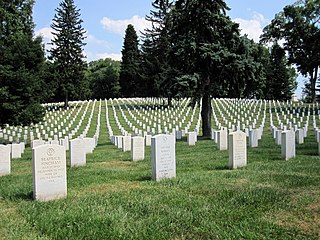
Culpeper National Cemetery is a United States National Cemetery located in the town of Culpeper, in Culpeper County, Virginia. Administered by the United States Department of Veterans Affairs, it encompasses 29.6 acres (120,000 m2) of land, and as 2021, had over 14,000 interments.
Rose Hill Cemetery may refer to:

Armstrong Chapel United Methodist Church is a historic church in the city of Indian Hill, Ohio, United States. Built in 1831, it is a small rectangular building with a prominent front tower. It was designated a historic site in 1975.

West Laurel Hill Cemetery is a historic rural cemetery located in Bala Cynwyd, Pennsylvania. It was founded in 1869, is 200 acres in size and contains the burials of many notable people. It is affiliated with Laurel Hill Cemetery in neighboring Philadelphia. The cemetery property is an accredited arboretum and has an on-site funeral home and crematorium. The cemetery contains two Jewish burial sections and an environmentally friendly burial section. The cemetery was listed on the National Register of Historic Places in 1992.

Washington Township is one of fifteen townships in Wayne County, Indiana, United States. As of the 2010 census, its population was 1,436 and it contained 626 housing units.

This is a list of the National Register of Historic Places listings in Cleveland, Ohio.

Oakwood Cemetery is a nonsectarian rural cemetery in northeastern Troy, New York, United States. It operates under the direction of the Troy Cemetery Association, a non-profit board of directors that deals strictly with the operation of the cemetery. It was established in 1848 in response to the growing rural cemetery movement in New England and went into service in 1850. The cemetery was designed by architect John C. Sidney and underwent its greatest development in the late 19th century under superintendent John Boetcher, who incorporated rare foliage and a clear landscape design strategy. Oakwood was the fourth rural cemetery opened in New York and its governing body was the first rural cemetery association created in the state.

The City of London Cemetery and Crematorium is a cemetery and crematorium in the east of London. It is owned and operated by the City of London Corporation. It is designated Grade I on the Historic England National Register of Historic Parks and Gardens.
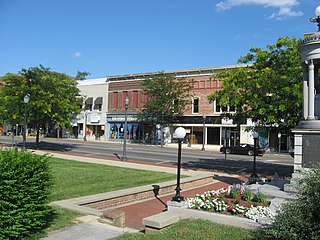
Washington Court House is a city in Union Township, Fayette County, Ohio. It is the county seat of Fayette County and is located between Cincinnati and Columbus. The population grew almost 1.5% from 2010 to 2020 approaching 14,401 people according to the 2020 census results. The area was initially settled by Virginia veterans of the American Revolution, who received the land from the government as payment for their service in the war.
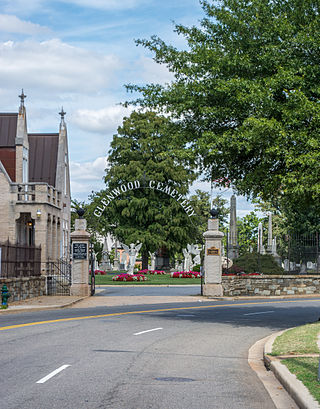
Glenwood Cemetery is a historic cemetery located at 2219 Lincoln Road NE in Washington, D.C. It is a private, secular cemetery owned and operated by The Glenwood Cemetery, Inc. Many famous people are buried in Glenwood Cemetery, and the cemetery is noted for its numerous elaborate Victorian and Art Nouveau funerary monuments. The cemetery was listed on the National Register of Historic Places in 2017; its mortuary chapel was separately listed in 1989.
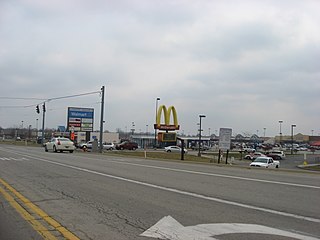
The William Burnett House was a historic farmhouse located near the city of Washington Court House in Fayette County, Ohio, United States. Constructed in the nineteenth century, it was once a masterpiece of multiple architectural styles, and it was designated a historic site because of its architectural distinction.

The Rawlings-Brownell House is a historic residence on the northern side of Washington Court House, Ohio, United States. Built during the middle of the nineteenth century, it was home to the man who established the neighborhood in which it is located, and it was later the home of a leading merchant. Although constructed in one architectural style, it was later partially converted into another style, becoming a good example of changes in the community's architectural tastes. It has been designated a historic site.
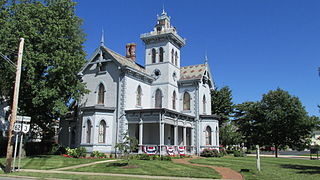
The Morris Sharp House is a historic residence in the city of Washington Court House, Ohio, United States. Built to be the home of one of the city's leading citizens, it has remained the architectural landmark that it was designed to be. The house has served as a museum for nearly fifty years, and it has been designated a historic site.
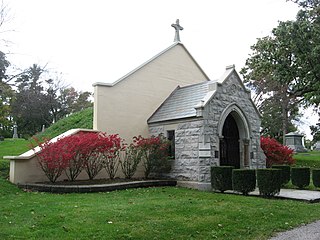
The Marion Cemetery Receiving Vault is a funerary structure in the main cemetery of Marion, Ohio, United States. Constructed in the 1870s, this receiving vault originally fulfilled the normal purposes of such structures, but it gained prominence as the semipermanent resting place of Marion's most prominent citizen, U.S. President Warren G. Harding.

Woodland Cemetery is a historic rural cemetery located at 6901 Woodland Avenue in Cleveland, Ohio. Established in 1853, it became Cleveland's main public cemetery after its founding and remained so for the next half-century. It fell into extreme disrepair, and most of its outstanding architectural features dismantled or demolished. In 1986, Woodland Cemetery was added to the National Register of Historic Places. The cemetery has since undergone restoration.























